Fayzulla Khodjaev Museum
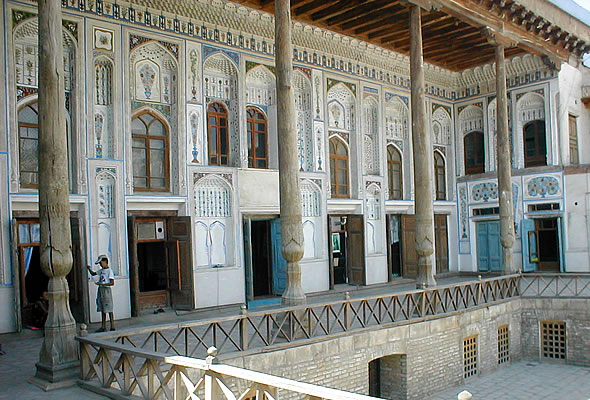
Fabrics of the XIX-XX cc
The collection includes the fabrics produced in silk-weaving centers of Central Asia such as Bukhara, Kitab, Qarshi, Khodjent, Samarkand, Margilan, and Kokand. Besides, there are several kinds of fabrics brought from India, China, Russia, and other European countries. The samples of hand-made fabrics, mainly silk, semi-silk, and cotton, are represented by shohi, beqasam, adras, alocha, bakhmal, gulbosma, qalami fabrics as well as block-prints.
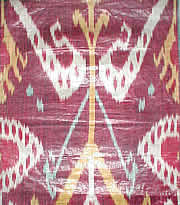
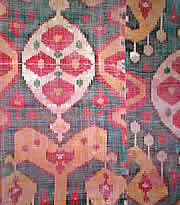
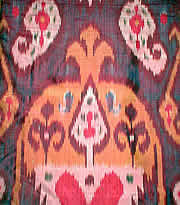
Clothes
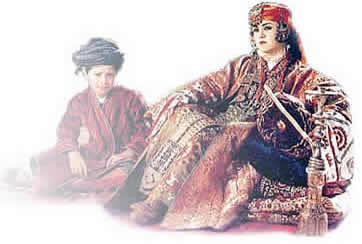
Women’s, men’s and children’s clothes such as kuylak, kaltacha, parandja, chachvan, lozimi, robes, gowns, and pants (19th – 20th cc.) made of shohi, podshohi, kundal, adras, bakhmal, and khon-atlas, the famous Bukharan silk, semi-silk, cotton, and velvet fabrics.
How to Reach
Ark, the citadel of the Bukharan rulers
2 Afrasiyab Street, Registan square, BukharaCity transportation
Public buses # 8, 6, 23
Fixed-route taxi (marshrutka): 51, 53, 56, 58, 76
Registan bus-stop
Museum of Decorative – Applied Art, Sitora-i Mohi Khosa
Mohi Khosa village, BukharaCity transportation
Buses # 7, 9
Fixed-route taxi: 70, 84 Mohi
Khosa bus-stop
Kamoliddin Behzod Fine Arts Museum
41 Naqshband Street, BukharaCity transportation
Fixed-route taxi: 52, 68
Fire Department bus-stop
Zindan, the emir’s dungeon
2 Balimanova Street, BukharaCity transportation
Buses # 8, 6, 23
Fixed-route taxi: 51, 53, 76
College of Culture bus-stop
Fayzulla Khodjaev Memorial House – Museum
70 A. Tuqay Street, BukharaCity transportation
Buses # 15
Fixed-route taxi: 64
Remontnaya kontora (Repair Workshop) bus-stop
Abu Ali ibn Sino Memorial Museum
Afshona village, Peshku district, Bukhara regionCity transportation
Bukhara – Peshku bus or taxi
Abdurauf Fitrat Memorial Museum
B.Nakshband Street, BukharaCity transportation
Buses # 10, 16, 60
Fixed-route taxi: 6, 60, 68, 100
Carpet-Making Museum, the Maghoki Attori Mosque
Naqshband StreetCity transportation
Fixed-route taxi: 52, 68
Fire Department bus-stop
Museum of the Varakhsha Settlement History
177 Mehtar Anbar StreetCity transportation
Fixed-route taxi: 52, 68
Fire Department bus- stop
History Museum of Restoration and Protection of Architectural Monuments of Bukhara and Bukhara Oasis, the Ulughbek Madrasah (1417)
33 Khoja Nurobod Street (near the Zargaron trade dome), BukharaCity transportation
Buses # 6, 8
Fixed-route taxi: 51, 56, 68
Museum of Wood Carving Art, the Abdulazizkhan Madrasah (1652)
22 Khoja Nurobod Street (near the Zargaron trade dome), BukharaCity transportation
Buses # 6, 8
Fixed-route taxi: 51, 56, 68
Museum of Water-Supply History, the Chashmai Ayub Mausoleum, (12th-16th cc.)
The Samanids National Park, Bukhara (near the farmers’ market)
33 Khoja Nurobod Street (near the Zargaron trade dome), BukharaCity transportation
Buses # 6, 8, 16, 23
Fixed-route taxi: 51, 53, 63, 76
Tariqati Naqshbandiya Museum
Qasri Orifon village, Kagan district, Bukhara regionCity transportation
Fixed-route taxi: 60
Sadridin Ayni and Jalol Ikromi Museum – Hudjra (Dwelling – Cell), the Kukeldash madrasah (1578)
91 Mehtar Anbar Street, Labi Haus architectural ensemble.City transportation
Fixed-route taxi: 52, 68
Fire Department bus-stop
Blacksmith’s Museum – Workshop, the Kulyuta Karavansarai (16th c.)
12 Haqiqat Street, Toqi Telpakfurushon trade domeCity transportation
Fixed-route taxi: 52, 68
Fire Department bus-stop
Exhibition-Sale, the Nadir Divanbegi khonaqo (17th c.)
Labi Hauz architectural ensemble, BukharaVisitors can view and purchase the samples of the modern decorative-applied arts.
City transportation
Fixed-route taxi: 52, 68
Fire Department bus-stop
Romitan Museum of History
17 Yakhshi Navruzov StreetCity transportation
"Bukhara – Romitan", "Bukhara – Yangibazar" public buses and route taxis
Tours and Lectures
Tours
For those decided to visit the museums of Bukhara alone or with family or friends, the tour bureau offers thematic tours along the diverse exhibitions of the museum-preserve – both in the old section of the city and its suburbs.
Qualified tour – guides and museum’s research fellows conduct tours in English, German, Russian, Uzbek, and Tajik. In correspondence with secondary and higher educational curriculum, students and pupils are arranged special courses such as tours and interactive lessons on the history and culture of Central Asia.
You can find details about the content of excursions in the tour office.
Contact Information: (365) 224-38-53
Lectures
The richest history and culture of Bukhara and Uzbekistan are highlighted in the lectures given by the scholars of the museum. You can find the lecture curriculum in the tour bureau.
Contact Information
General Information
General information on the Ark museum
Assistant Director on general issues
(365) 224-13-78
Assistant Director on scientific-research affairs:
(365) 224-13-66
Research Departments
History Department
(365) 224-13-66
Registration Sector
(365) 224-14-04
Tour Bureau
(365) 224-38-53
"Open Treasury" Computer Center
(365) 224-37-94
Bukhara Museum Friends’ Club
(365) 224-38-53
Museum Filials
Museum of Decorative-Applied Arts
(365) 228-50-47
K. Behzod Fine Arts Museum
(365) 224-58-53
Fayzullo Khodjaev Memorial House-Museum
(365) 224-41-88
Zindan, emir’s dungeon
(365) 224-95-02
Exhibition-Sale, the Divanbegi khonaqo
(365) 224-45-48
Blacksmith’s Museum-Workshop
(365) 224-57-65
"Wood Carving Art" exhibition
(365) 224-24-60
History Museum of Restoration of Architectural Monuments of Bukhara
(365) 224-24-60
Museum of Water-Supply History
(365) 224-39-02
Fitrat Memorial Museum
(365) 223-22-84
Al- Bukhari Museum
(365) 224-42-90
Museum of Varakhsha Settlement History
(365) 224-55- 62
Ibn Sino Memorial Museum
(365) 354-51- 42
Carpet Museum
(365) 224-15-91
Nodir Devonbegi Khonaqo
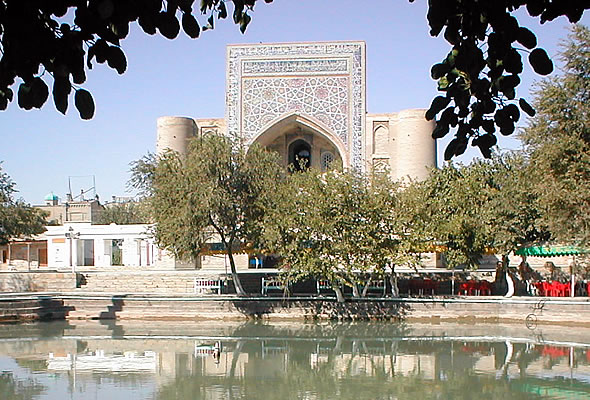
Decorative – Applied Art
The applied art collection has 2,420 articles. The collection mainly includes the belongings left after the Bukharan emir. These are crockery items, furniture, and jewelry artifacts.
The most impressive is the collection of the jewelry artifacts such as the golden plate and earrings (2nd c. BC) found in the burial mounds of the Bukhara region. There are great quantities of women’s and men’s jewelry articles of the 19th- 20th centuries.
The museum has spectacular collection of silver dishes such as the tea- and dinnerwares, wineglasses, and cases for the Koran.
Archeology
The collection of archaeological objects is divided into 67 collections. It consists of 10, 523 items. Of those 489 are related to the Neolithic- (the Darbazakir settlement, the 5th -3rd cc. BC) and 57 to the Bronze Ages (the Zamon-bobo settlement, the 3rd -2nd cc. BC).
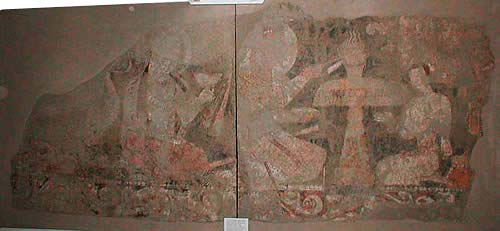
Information about Museum Departments
History department (from ancient time to early 20th century)
This is one of the oldest research departments in the museum, functioning since 1923. It also includes the archaeology section. The department’ s depository has about 14,000 objects. There are six members of the staff in the department. The department chair is M. Niyazova.
Department of Numismatics and Epigraphy
The department has been working since 1987. It has 19, 880 items. The formation of the collection dates back to the 1920s; it mainly includes the coins found during the archaeological excavations in the territory of Bukhara and its suburbs. There are two specialists in the department. The department chairperson is G. Kurbanov, PhD in History.
Nature Department
The Nature Department has been functioning since 1951. It has 536 exhibits. There are three specialists in the department. The department chairperson is S. Habibulina.
Tour-Education Department
The department was established in 1972. Its main task is to introduce public to the multiple collections of the museum-preserve. There are 32 members of the staff, including methodologists and tour- guides. Tours are held in Uzbek, Russian, Tajik, English, and German. Each year, the department conducts around 30,000 tours and gives about 700 lectures. The department chairperson is F. Arslanova.
Department of Contemporary History and Ethnography
The department was established in 1975. It has two sectors. The first sector consists of documentary materials and gramophone records, which include 32,456 exhibits. The latter keeps the samples of material culture with 3,099 objects. In total, the department possesses about 36,000 objects. There are 11 members of the staff in the department. The department chairperson is B. Qobilov.
Sitora-i Mohi Khosa Park-Palace Complex
This branch of the museum has the following exhibitions:
- Interior of the summer palace (main body)
- National clothes of urban dwellers of Bukhara (19th – 20th cc.), the octagonal pavilion
- Art embroidery and objects of everyday use (19th – 20th cc.)
- Palace furniture of the 19th – 20th century, the bedroom section
The museum-complex stores about 1,500 exhibits. There are four research fellows in the Sitora – i Mohi Khosa complex.
The branch has under material protection the depositories of:
- Metal collection – 3,048 exhibits
- Wood carving – 1,085 exhibits
The branch chairperson is B. Buranov.
Kamoliddin Behzod Fine Arts Museum
The museum includes the art gallery and the “Ancient Jewelry Art of Bukhara” exhibition.
The art gallery was set up in 1982. The formation of the collection began in 1932. Among the collections unique are the works by P. Benkov, Karakhan, M. Kurzin, and U. Tansikbayev. About 1,000 samples of painting, graphics, sculpture, and miniature-painting could be found in the museum’s reserves. The “Ancient Jewelry Art of Bukhara” exhibition was set up in 1994 in the storeroom of the former state bank. There are five specialists in the museum. The branch chairperson is Q. Jumayev, PhD in History.
Research Library
The research library is one of the oldest libraries in Bukhara. It mainly includes Amir Said Alimkhan’s (1911-1920) personal collection of books, consisting of the manuscripts and lithographic publications of the 17th – 20th centuries. Now, the collection is kept at the center for studying Oriental manuscripts, which is located at the Kamoliddin Behzod Fine Arts Museum. The library of the Ark museum has more than 5,000 publications on history, art, ethnography, and architecture.
The museum has two research centers:
- The Center for Study Arabic – Written Oriental Manuscripts
- The Center for Study Spiritual Legacy of Bahouddin Naqshband
The museum also has the “Open Treasury” computer center, where visitors will be acquainted with the online collections of the museum’s reserves.
In October 2001, the museum’s staff worked out the project of computerization of the museum’s depositories. The grant awarded by the U.S. Embassy in Uzbekistan enabled the museum to purchase computers and other necessary equipments.
The museum has the “Friends of the Bukhara Museum-Preserve” society. Its purpose is to support the museum in various projects on preservation, exhibition, restoration of the unique collections kept in the museum’s depositories.

